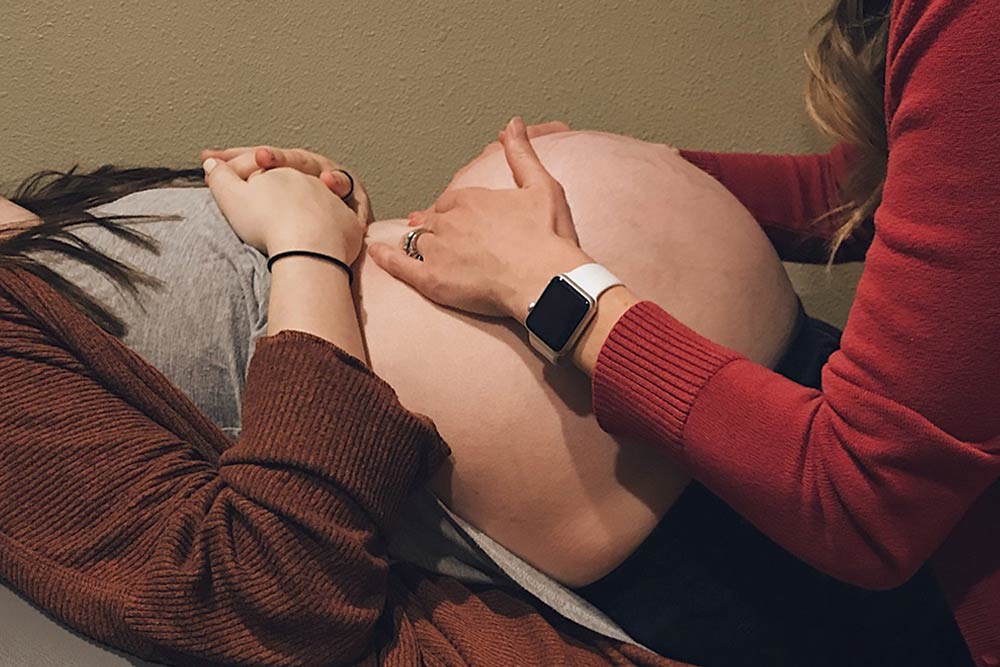What is a Midwife?

If you’re seeking a more individual birthing experience and a holistic approach to care, a midwife may be just what you’re looking for.
By Jennifer Wittes
Updated by Ashley Ziegler
Experts: Dr. Susan-Rachel Condon, LM, DM and Tesa Lubons Dehaven, LM, CPM
By and large, moms-to-be rely on the expertise of an OB for prenatal care, but in recent years, a growing number of expectant women are asking midwives to take the lead.
As a certified postpartum doula, I intrinsically respect a woman’s choice and the individual nature of each birth experience. I myself birthed one of my children in a hospital and one at home, and both experiences were amazing in their own right.
What I will say of midwifery care, in particular, is that it felt like working on my own project under the guidance of extremely knowledgeable peers—I called the shots but valued their presence and expertise as care providers, and to an extent, friends. I still keep in touch with my midwives via email and social media, especially every year around my son’s birthday. I can’t say the same of the OB who delivered my daughter; I met her while pushing, was in the same room as her for about 30 minutes, and never saw her again. This isn’t to say this is the norm, but it is to say that midwives are pretty darn special.
What Exactly Does a Midwife Do?
The modern midwife is a skilled professional with credentials who has been through some form of training, usually a lengthy apprenticeship and likely a formal certification program. According to Tesa Lubons Dehaven, LM, CPM, a licensed midwife and certified professional midwife practicing in Weaverville, California, there are three primary types of midwives: certified professional midwives (CPM), certified nurse midwives (CNM), and certified midwives (CM). Each type of certification has its own training and qualifications.
Generally speaking, CPMs are autonomous and specialize in out-of-hospital births. CNMs and CMs work in a variety of birth settings, including hospitals, clinics, and birth centers, as well as in home-birth care.
Unlike traditional health care providers, most midwives provide care to the birthing parent before, during, and after the birth of the baby, as well as to the baby during the first 28 days of life. Depending on their certification, Dehaven says, “midwives provide initial and ongoing comprehensive assessment, diagnosis, and treatment” to new parents, and some can even do everything from comprehensive physical examinations to prescribing medications to counseling.
Despite the slight differences between certifications, what seems almost universally true of all midwives is their devotion to pregnant parents. They view a client’s health wholly—mental, emotional, and physical—and rely on truly getting to know each person in order to provide the best possible care. They’re extremely available, present, and patient by nature, and come to each situation with a large skill set, well-crafted intuition, and a passion for what they do.
“Each midwife has a different story,” says Susan-Rachel Condon, LM, co-founder of River & Mountain Midwives and Hudson Valley Midwifery Center in Kingston, New York. “For me, the best part of my job is bearing witness to the hard work [birthing parents] do. The work impacts [the client] on every level—social, cultural, physical, emotional, and spiritual. Each [birthing parent] deserves to have an informed and nonjudgmental ally. That’s me.”
What is the Difference Between a Midwife and a Doctor?
On a fundamental level—for a normal, low-risk pregnancy—midwives are not all that different from health care providers in obstetrics. Both are trained in labor and delivery. Both are present at the moment of birth. Both perform immediate postnatal procedures for the mother and infant.
But looking closer, you’ll notice some key contrasts. Dehaven explains, “Midwives provide the midwifery model of care and provide perinatal, primary, and reproductive health care and education to [birthing parents] in the home, birth center, and hospital setting.” Additionally, she says, “[midwives] are trained professionals with specific advanced training in the management of normal pregnancy, birth, postpartum care, reproductive health care, and newborn wellness.” Midwives have a more holistic approach to health care and often a strong leaning toward natural childbirth. They see birth as a natural, empowering experience.
Obstetricians (OB), on the other hand, have completed medical school and specialty residencies. Additionally, they “practice the medical model of care,” says Dehaven, which “views pregnancy and birth as a pathological event requiring intervention and assistance to occur safely.” OBs might be more apt to utilize pain medication, such as an epidural. Also, when a birthing parent chooses an OB-GYN, they are choosing to deliver their baby in a hospital setting. (Prenatal visits may also be held in a hospital setting.)
What Are Some Benefits of Having a Midwife?
In addition to the difference in training and philosophies between an OB and a midwife, the prenatal, birthing, and postpartum experience for parents as a whole is also quite different.
For example, with far fewer clients than OBs, midwives are able to make themselves readily available to their clients and are more actively involved in the birthing process, offering physical and emotional support along the way. When the time comes for the birthing parent to go into labor, a midwife is on-call 24/7. If a birthing parent has a question or concern, they can ask their specific caregiver directly, no matter the time of day.
Midwives’ accessibility stretches to general care as well. “Midwives focus on preventative care and do a lot of education with their clients,” explains Dehaven. A midwife spends an average of one full hour with a birthing parent during a prenatal checkup. During this visit, the midwife and client will talk about everything—stress, diet, relationships, and emotional history. A midwife’s assessments and recommendations are made not from a routine checklist but from a deep understanding of the individual parent.
This level of care continues into labor, birth, postpartum care, and beyond. Home-birth midwives will visit the family several times after birth to assess postpartum health, weigh the baby, and provide breastfeeding assistance. Also, Dehaven notes, “Midwives offer continuity of care until six weeks postpartum and help [new parents] establish lactation.” And, although clinic and birth center midwives don’t necessarily visit the home, they do follow the spirit of the midwifery tradition as well.
Finally, while there are no guarantees, Dehaven explains that pregnancy outcomes are often better with the use of a midwife. “Midwifery serves to reduce the likelihood that you’ll need a cesarean or that you’ll have substantial tearing,” she says, and “midwives have been shown to reduce neonatal and maternal mortality and morbidities, and to statistically reduce negative perinatal outcomes associated with a historic increase in interventions in today’s maternity care.”
What if There Are Complications?
There are certainly plenty of good reasons birthing parents may opt to deliver with a midwife, but parents need to understand the limits to the care they will receive. A midwife is medically minded when they need to be and carries standard birth equipment, including IV and suturing supplies. However, if complications arise during labor or delivery, a midwife will step aside and let an OB take over. Specifically, midwives are not able to perform a cesarean, so an OB will need to intervene should you require a C-section.
This risk is relatively low, though, and midwives are well-trained and prepared for these situations, so even if they arise, you’re still in very good hands. “Hiring a midwife doesn’t guarantee you the birth you want, but it does give you a better shot at achieving what you want while being treated as a participant in your care [as] you navigate the rite of passage of becoming a parent,” says Dehaven.
Usually, parents who have opted to partner with a midwife for their labors and deliveries have been happy with their results. Nicole Capehart, for example, is a mom in Albuquerque, New Mexico who gave birth twice in a hospital setting—once with an OB and once with a midwife from a midwifery clinic. She says, “I loved every bit of my experience with my midwife. I think what I loved most was that she listened. She took me seriously and took my opinions into consideration when something didn’t feel right. I wasn’t just another patient to check off her list. She empowered me to have the best birth possible.” And this outcome is the exact goal of every trained midwife.








